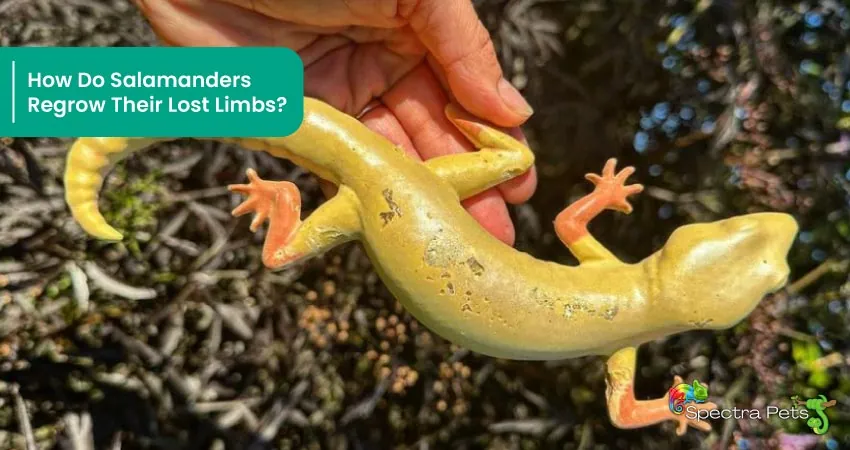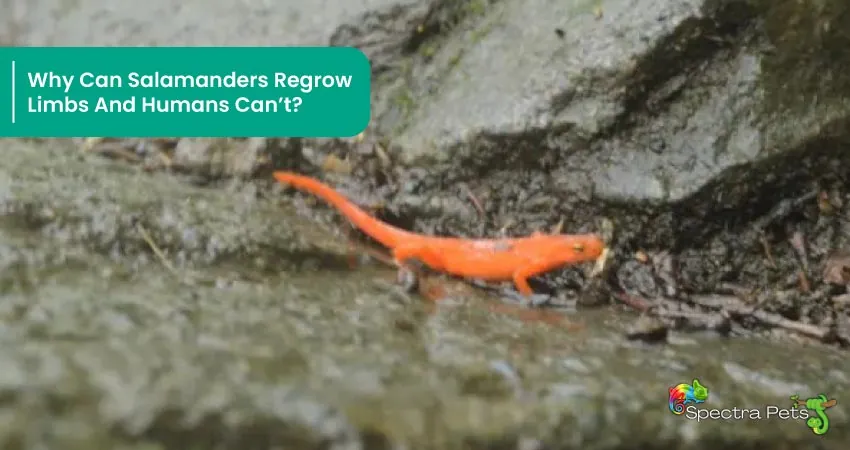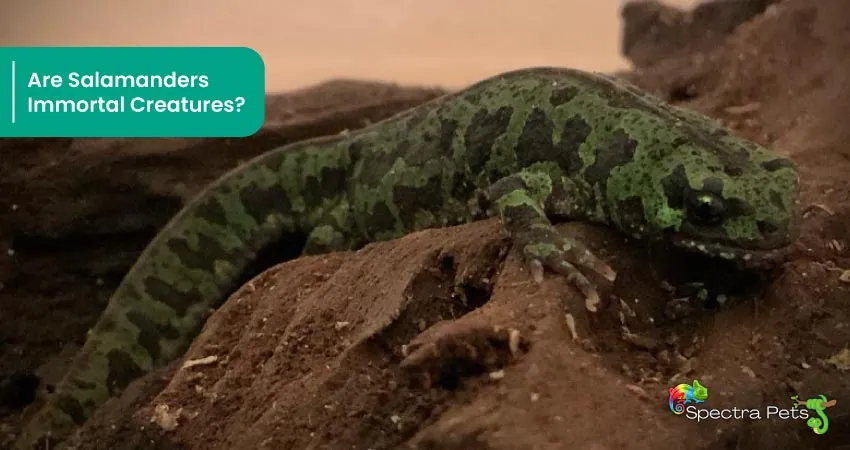Time and time again, people have had a lot of myths about salamanders. For example, salamanders are descendants of fire breathing dragons, or they grow wings, even that they can regrow the limbs that might be lost. But the thing about myths is- some of them could be true.
In this case, it turns out there may be some truth to this ancient tale after all, some salamander species do indeed regrow their limbs.
Recent years have seen scientists make tremendous progress in understanding salamander regeneration, setting a new standard for regeranational science. Why not be a part of this discovery by taking a look at the fascinating topic of salamander limb regeneration? I’ve covered all the necessities down here…
What Is Regeneration?

Life involves regeneration by nature. An organism can repair or replace damaged or lost tissues or organs through a process known as regeneration. Numerous species of animals, such as salamanders, zebrafish, and some types of worms and sea stars, possess this skill.
Depending on the species and the kind of tissue being regenerated, regeneration can take place through a number of different mechanisms. Stem cells, which are undifferentiated cells that can divide and differentiate into the precise cell types required to repair or replace damaged tissues, may in some circumstances be activated as part of the regeneration process.
In other situations, regeneration may entail the activation of specialized cells or tissues that are already in the body and have the capacity to replace or repair damaged tissues.
Regeneration can occur at different stages of an organism’s life, and it can involve the regrowth of a wide range of tissues and organs, including skin, bone, muscle, nerve tissue, and even the heart and other internal organs. Salamanders, for example, can regrow lost limbs and other body parts, whereas humans have a more constrained capacity for regeneration.
Researchers are interested in studying regeneration in a variety of animals as it may shed light on the biology of regenerative processes in humans and other animals. New therapies and treatments for a variety of conditions, such as injury, disease, and aging, may be developed as a result of our growing understanding of how regeneration works in other animals.
So, how does this regeneration process work on salamanders? I’ve tried to explain it in greater detail in the next section. Have a look:
How Do Salamanders Regrow Their Lost Limbs? Can They Regrow Anything?

Salamanders are an amazing group of animals known for their ability to regenerate lost limbs and other body parts. This remarkable ability is found in many species of salamanders, and it has long been a source of fascination for biologists and researchers.
First of all, what you need to understand about salamander regeneration is that it is a complex process that involves multiple stages and requires the coordinated action of many different cells and tissues. When a salamander loses a limb, the process of regeneration begins almost immediately.
The first stage of regeneration involves the formation of a temporary structure called a blastema, which is a mass of cells that will eventually give rise to the new limb. The blastema is formed by the activation of stem cells in the salamander’s body, which are capable of dividing and differentiating into any type of cell needed for the regrowth process.
Once the blastema has formed, it begins to differentiate into the various cell types needed to form the new limb. This process is guided by a number of growth factors and signaling molecules, which help direct the development of the new limb.
As the new limb continues to develop, the cells in the blastema become organized into the various tissues and structures that make up the limb, such as muscle, bone, and skin. Finally, the new limb is complete, and the salamander is able to use it to move and function as normal.
It’s important to note that not all salamanders are able to regenerate lost limbs to the same extent. Some species, such as the axolotl, are capable of regenerating almost any body part, including the heart, spinal cord, and even parts of the brain. Other species, such as the newt, are able to regenerate lost limbs but may not be able to regenerate other body parts as effectively.
Despite this variation in regenerative ability among different salamander species, the basic process of regeneration is similar across all species. Understanding this process has the potential to provide important insights into the biology of regenerative processes in other animals, including humans.
Why Can Salamanders Regrow Limbs And Humans Can’t?

Salamanders have a much superior regenerative ability than humans. But why is that so?
These amphibians have the ability to regenerate their limbs because they have cells called stem cells that can divide and differentiate into different types of cells, including muscle, bone, and nerve cells. These stem cells are found in the blastema, a mass of undifferentiated cells that forms at the site of the amputation. As the blastema grows, it differentiates into the various cell types needed to regenerate the limb.
In humans, stem cells are also present, but they are not as abundant or as versatile as those found in salamanders. In addition, the human body has a number of mechanisms in place that prevent the uncontrolled growth of cells, which can lead to the development of tumors. As a result, humans are not able to regenerate lost limbs or other body parts in the same way that salamanders can.
However, it is possible that advances in stem cell research and regenerative medicine could someday lead to treatments that allow humans to regenerate lost limbs or other body parts. Researchers are actively studying the mechanisms behind salamander limb regeneration and looking for ways to apply this knowledge to the development of new therapies for humans.
How Long Does It Take For A Salamander To Regrow A Tail?

So, how long does it actually take for a salamander to regenerate its amputated tail?
Well, the exact timing can vary depending on a number of factors, including the species of salamander, the size of the tail, and the conditions in which the salamander is living. In general, it takes several weeks or months for a salamander to regenerate a lost tail.
The process of tail regeneration begins shortly after the tail is lost. The stump of the tail will form a scar and a blastema. The blastema will then begin to differentiate into the various cell types needed to regenerate the tail, including muscle, bone, and nerve cells. As the blastema grows and differentiates, it will take on the shape of the original tail, and the salamander will begin to use its new tail for movement and balance.
In some cases, the regenerated tail may not be exactly the same as the original tail. The regenerated tail may be slightly shorter or have a different shape, and it may not have all of the same functions as the original tail. However, the regenerated tail is usually functional and allows the salamander to move and behave normally.
Are Salamanders Immortal Creatures?

Does this superior regenerative ability make salamanders immortal?
Realistically, the answer to this question is no. Like all living organisms, salamanders have a finite lifespan and will eventually die. The lifespan of a salamander can vary depending on the species, with some species living longer than others. Some salamander species can live for several decades, while others may only live for a few years.
Additionally, although salamanders are able to regenerate lost body parts, including limbs and tails, this ability does not make them immortal. The process of regeneration requires a significant amount of energy and resources, and repeated regeneration can eventually take a toll on the salamander’s overall health and well-being.
Last but not least, salamanders are vulnerable to predators and other environmental hazards, which can also contribute to their mortality.
Wrapping Up
Regrowing lost limbs by salamanders has long fascinated scientists. Salamander regeneration research and study is allowing scientists to understand how humans can benefit from understanding salamander regeneration.
This begs the question, are there other creatures in this world that have mechanism which humankind can benefit from? I guess we’ll find out in due time.

